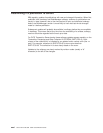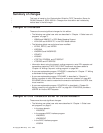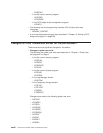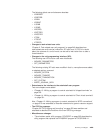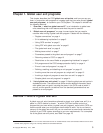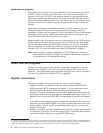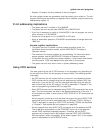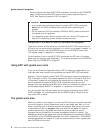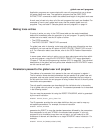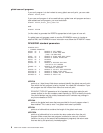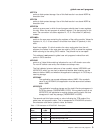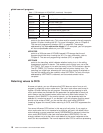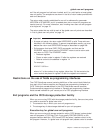
Each global user exit point has a unique identifier, and is located at a point in the
module or domain at which it could be useful to do some extra processing. For
example, at exit point XSTOUT in the statistics domain, an exit program can be
given control before each statistics record is written to the SMF data set, and can
access the relevant statistics record. You might want to use an exit program at this
exit point to examine the statistics record and suppress the writing of unwanted
records.
Global user exit support is provided automatically by CICS. However, there are
several conventions that govern how you write your exit program, which are
described in “Global user exit programs”. Also in that section is a list of the standard
parameters that the calling modules and domains pass to an exit program, and
some information about returning values to the caller.
Because global user exit programs work as if they were part of the CICS module or
domain, there are limits on the use you can make of CICS services. Most global
user exit programs cannot use EXEC CICS commands. By contrast, most global
user exit programs can invoke some CICS services using the exit programming
interface (XPI). For more information, see “Using CICS services” on page 5.
Note: Neither source nor object compatibility of CICS management modules is
guaranteed from release to release. Any changes that affect exit programs
are documented in the appropriate manual.
Global user exit programs
A global user exit program must be written in assembler language and must be
quasireentrant. However, if your user exit program calls the XPI, it must be fully
reentrant.
2
(For details about coding programs using XPI calls, refer to “Chapter 3.
The user exit programming interface (XPI)” on page 283.)
Register conventions
The following register values are provided on entry to an exit program:
v Register 1 contains the address of the user exit parameter list DFHUEPAR.
Write-to-operator (WTO) commands use register 1. If your exit program uses
WTO commands, you should save the address of DFHUEPAR first.
v Register 13 contains the address of the standard register save area where your
exit program should store its own registers immediately after being invoked. This
address is also in the field UEPEPSA in the parameter list pointed to by register
1.
If you want to issue operating system requests that use register 13 to point to a
save area, you must switch register 13 to point to another save area. You must
restore register 13 to its original contents before returning from your user exit
program to the caller.
v Register 14 contains the return address to which the exit program should branch
on completion of its work. You do this using the BR 14 instruction after restoring
the calling module’s registers, or using the RETURN macro.
2. A “reentrant” program is coded to allow one copy of itself to be used concurrently by several tasks; it does not modify itself while
running. A “quasireentrant” program is serially reusable by different tasks. When it receives control it must be in the same state as
when it relinquished control. Such a program can modify itself while running, and is therefore not fully reentrant.
global user exit programs
4
CICS TS for OS/390: CICS Customization Guide



